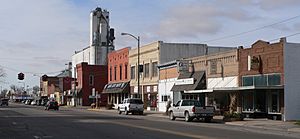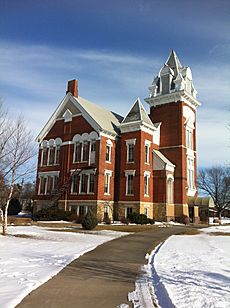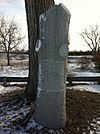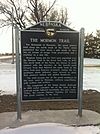Central City, Nebraska facts for kids
Quick facts for kids
Central City, Nebraska
|
|
|---|---|

Downtown Central City: G Street
|
|

Location in Merrick County and the state of Nebraska
|
|
| Country | United States |
| State | Nebraska |
| County | Merrick |
| Established | 1866 |
| Current name | 1875 |
| Area | |
| • Total | 2.42 sq mi (6.27 km2) |
| • Land | 2.42 sq mi (6.27 km2) |
| • Water | 0.00 sq mi (0.00 km2) |
| Elevation | 1,696 ft (517 m) |
| Population
(2020)
|
|
| • Total | 3,039 |
| • Density | 1,254.75/sq mi (484.43/km2) |
| Time zone | UTC-6 (Central (CST)) |
| • Summer (DST) | UTC-5 (CDT) |
| ZIP code |
68826
|
| Area code(s) | 308 |
| FIPS code | 31-08535 |
| GNIS feature ID | 837913 |
Central City is a friendly city in Nebraska, USA. It is the main town, or county seat, of Merrick County, Nebraska. This city is also part of the larger Grand Island metropolitan area. In 2020, about 3,039 people lived here.
Contents
A Look Back: Central City's History
Early People: The Pawnee Tribes
Long ago, before Central City was founded, the Pawnee people lived here. In the late 1700s, a group of Pawnee called the Chaui (Cáwiiʾi) had a village where Central City is now.
There was a big rivalry between the Chaui and another Pawnee group called the Skidi. One time, the Skidi attacked some Chaui hunters. About 200 Chaui men were killed. The Chaui, who were from the village near what is now Central City, felt they were not strong enough to fight back alone.
So, the Chaui asked two other Pawnee groups for help. These groups, the Pitahauerit and Kitkehahki, agreed to join them. Together, the three groups planned a clever attack. They crossed the Platte River at night. Some men dressed as buffaloes to trick the Skidi into coming out to hunt.
The rest of the warriors hid along the river and behind sandhills. When the Skidi chased what they thought were buffaloes, they ran right into the trap. Many Skidi warriors were killed in the battle. The Chaui and Pitahauerat wanted to completely defeat the Skidi. But the Kitkehaki argued that they were all Pawnee people and should not destroy each other.
The Kitkehaki won the argument. The groups talked and made peace. The Southern Pawnees took many horses and other goods from the Skidi. Many Skidi women married into the other villages. This helped to create stronger family ties among the different Pawnee groups.
How Lone Tree Was Founded
The first pioneers traveled through this area on trails like the Mormon Trail in 1847. Later, the Oregon Trail and California Trail also passed nearby. A very large cottonwood tree, known as Lone Tree, was an important landmark for these travelers.
In 1858, the government of Nebraska created Merrick County. It was named after Elvira Merrick. The county seat was planned to be under the Lone Tree and was first called "Elvira."
The actual town, named "Lone Tree," was started in 1866. This happened as the Union Pacific Railroad was building its tracks through Merrick County. In 1868, J.H. Berryman built the first important building. It was a general store, hotel, bar, courthouse, and his home all in one! The first official courthouse was built in 1871. It was later replaced by the current courthouse in 1912.
Changing the Name to Central City
In 1875, people in Lone Tree wanted to change the town's name to "Central City." They thought "Lone Tree" made the area sound empty and poor. They believed a new name would attract more settlers and help the town grow.
Others liked the name "Lone Tree." They felt it showed a "beautiful spot" and was special to the early settlers. But the people who wanted the change won. On July 1, 1875, the town officially became Central City. The new name showed its important location in Nebraska's farming region.
A Time of Growth: The Boom Town Years
By the 1880s, Central City was growing very fast, like a "boomtown." This was because a second railroad, the Burlington & Missouri River, arrived. During this busy time, many new buildings and businesses appeared.
Three banks were built, along with a hardware store and a roller mill. The town also got two newspapers, three lumberyards, and factories for crackers and cigars. A new brick school and nine churches were also built. Nebraska Central College, a Methodist school, opened in 1885.
The first newspaper, The Merrick County News, started in 1872. It later became the Courier. Other newspapers tried to start, but many didn't last long. By 1882, Central City had two newspapers again.
Economic growth slowed down by the 1890s. The Courier newspaper closed, and Nebraska Central College shut down in 1891. A flood even damaged both railroad tracks. But things got better in the mid-1890s. Two new newspapers opened. The Society of Friends (Quakers) reopened Nebraska Central College in 1899.
In the early 1900s, a new courthouse was built (1911–1913). The historic Martha Ellen Auditorium (built in 1916) and a new high school also appeared. The economy improved in the 1920s when a cold storage company opened. This helped farmers sell their poultry and eggs for better prices. A famous author and photographer, Wright Morris, lived in Central City from 1910 to 1919.
From the 1930s to Today
A library was built just before the Great Depression. Not much construction happened during the 1930s. In the 1940s, building started again with a new hospital and a high school gymnasium.
In the 1950s, Nebraska Central College closed again (1953). But a new hospital was built in 1959. In 1975, an explosion and fire destroyed a whole city block. Even with that, Central City reached its largest population in 1980, with 3,083 people. The population has gone down a little since then.
Historic Places and Buildings to Explore
National Register of Historic Places
Six places in or near Central City are listed on the National Register of Historic Places. This means they are important historical sites. To be listed, a place must be at least 50 years old. It also needs to be special because of historic events, famous people, or its unique architecture.
| Name on the Register | Image | Date listed | Location | City or town | Description | |
|---|---|---|---|---|---|---|
| 1 | Martha Ellen Auditorium |
(#88000944) |
706 C Ave. 41°06′53″N 98°00′09″W / 41.114722°N 98.0025°W |
Central City | ||
| 2 | Heber Hord House |
(#87002096) |
1505 16th St. 41°06′58″N 97°59′18″W / 41.116111°N 97.988333°W |
Central City | ||
| 3 | Wright Morris Boyhood House |
(#80002457) |
304 D St. 41°07′02″N 98°01′38″W / 41.117222°N 98.027222°W |
Central City | ||
| 4 | Nelson Farm |
(#09000650) |
1139 M Rd. 41°06′22″N 98°05′27″W / 41.106111°N 98.090833°W |
Central City | ||
| 5 | Patterson Law Office |
(#79001451) |
1517 18th St. 41°06′51″N 97°59′57″W / 41.114167°N 97.999167°W |
Central City | ||
| 6 | Riverside Park Dance Pavilion |
(#98001564) |
Riverside Rd. in Riverside Park 41°05′57″N 97°57′58″W / 41.099167°N 97.966111°W |
Central City |
Former Listing
| Name on the Register | Image | Date listed | Date removed | Location | City or town | Summary | |
|---|---|---|---|---|---|---|---|
| 1 | Merrick County Courthouse |
(#89002211) |
|
18th St. between 15th and 16th Aves. 41°06′50″N 97°59′57″W / 41.113889°N 97.999167°W |
Central City |
Nebraska State Historic Places
The Nebraska State Historical Society marks important events, people, and places in Nebraska's history. A marker can only be put up with their permission. Central City has two such markers: one for the Lone Tree and another for the Mormon Trail, which passed near the historic Lone Tree.
Geography: Where is Central City?
Central City is located in the east-central part of Merrick County. It is about 2 miles (3.2 km) northwest of the Platte River.
U.S. Route 30 runs through the city as G Street and 16th Street. This highway goes southwest about 22 miles (35 km) to Grand Island. It also goes northeast about 41 miles (66 km) to Columbus.
Nebraska Highway 14 passes through the center of town as 17th Avenue. It leads north about 18 miles (29 km) to Fullerton. It also goes south about 17 miles (27 km) to Aurora.
The U.S. Census Bureau says that Central City covers a total area of 2.44 square miles (6.32 square kilometers). All of this area is land.
Demographics: Who Lives Here?
| Historical population | |||
|---|---|---|---|
| Census | Pop. | %± | |
| 1880 | 648 | — | |
| 1890 | 1,368 | 111.1% | |
| 1900 | 1,571 | 14.8% | |
| 1910 | 2,428 | 54.6% | |
| 1920 | 2,410 | −0.7% | |
| 1930 | 2,474 | 2.7% | |
| 1940 | 2,460 | −0.6% | |
| 1950 | 2,394 | −2.7% | |
| 1960 | 2,406 | 0.5% | |
| 1970 | 2,803 | 16.5% | |
| 1980 | 3,083 | 10.0% | |
| 1990 | 2,868 | −7.0% | |
| 2000 | 2,998 | 4.5% | |
| 2010 | 2,934 | −2.1% | |
| 2020 | 3,039 | 3.6% | |
| U.S. Decennial Census 2012 Estimate |
|||
Central City's Population in 2010
In 2010, there were 2,934 people living in Central City. These people lived in 1,240 households, and 762 of these were families. The city had about 1,265 people per square mile (488 per square kilometer). There were 1,419 housing units, with about 612 units per square mile (236 per square kilometer).
Most of the people in Central City were white (96.5%). A small number were African American (0.1%), Native American (0.4%), Asian (0.2%), or Pacific Islander (0.2%). About 1.2% were from other backgrounds, and 1.4% were from two or more backgrounds. About 3.5% of the population identified as Hispanic or Latino.
About 28.8% of households had children under 18 living with them. Almost half (48.9%) were married couples. About 9.3% had a female head of household with no husband, and 3.3% had a male head of household with no wife. About 38.5% of households were not families.
Around 33.9% of all households were single individuals. About 16.3% had someone living alone who was 65 years old or older. The average household had 2.28 people, and the average family had 2.94 people.
The average age in Central City was 42.4 years. About 24% of residents were under 18. Around 7% were between 18 and 24. About 22.3% were from 25 to 44. Another 25.7% were from 45 to 64. Finally, 20.8% were 65 years or older. The city's population was 46.9% male and 53.1% female.
Notable People from Central City
- Wright Morris, a famous author and photographer
- Dick Wagner, an executive for the Cincinnati Reds baseball team
- Bill Wilson, a Major League Baseball player
See also
 In Spanish: Central City (Nebraska) para niños
In Spanish: Central City (Nebraska) para niños









